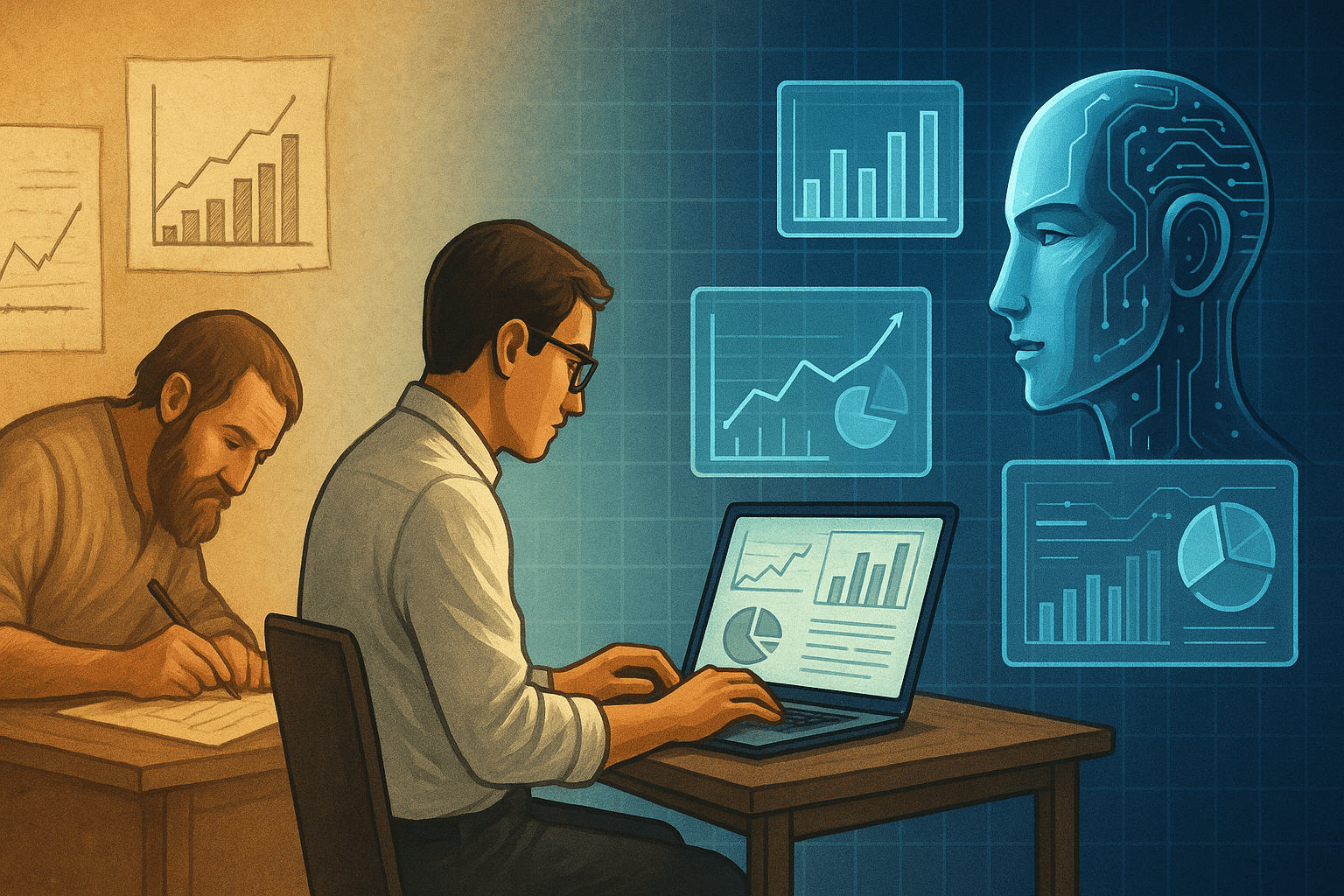
The Evolution of Analytics: Artisanal to Agentic
The Evolution of Analytics
Analytics in business has undergone a profound transformation over the decades, evolving through distinct eras shaped by technological advances and shifting organizational mindsets. The journey began with
Analytics 1.0 in the mid-20th century, characterized by manual, artisanal analytics where analysts worked with small, structured datasets to provide descriptive insights that helped businesses understand past events. This era focused primarily on internal decision support rather than predictive or prescriptive capabilities. As technology advanced, Analytics 2.0 emerged with the rise of big data and digital-native companies, turning analytics into a core business driver. Organizations began creating data products such as recommendation engines and personalized experiences, and the role of the data scientist was born alongside early machine learning applications in search and advertising. Analytics 3.0 marked the industrialization of analytics, with traditional companies embedding data-driven decision-making into their cultures and deploying thousands of machine learning models for real-time, prescriptive analytics. This phase required not only technical investment but also significant organizational change to succeed.
Today, we are in the era of Analytics 4.0, defined by agentic AI—autonomous, adaptive AI agents that proactively orchestrate complex workflows and make real-time decisions without human intervention. This era represents a fundamental shift from manual to automated processes and to intelligence embedded across business operations.
Thinking About Analytics 4.0
Analytics 4.0 is not just about smarter algorithms; it demands a new mindset and organizational capabilities. Companies must invest heavily in data infrastructure, cloud computing, and cross-functional teams that combine data science, software development, and business expertise. The hallmark of this era is AI agents capable of continuous learning and context-aware decision-making, enabling unprecedented operational efficiency and competitive advantage. These AI agents can autonomously identify bottlenecks, adapt to changing conditions, and optimize workflows, freeing human workers to focus on strategic tasks. For example, a retail bank using AI agents to automate credit-risk memos saw a 20 to 60 percent productivity increase and a 30 percent faster credit turnaround time. Another case involved a market research firm that reduced errors and boosted productivity by over 60 percent through AI-driven data anomaly detection and insight generation, saving millions annually.
Use-Cases Across Industries
The adoption of advanced analytics and AI varies widely across industries. Technology, media, finance, and professional services lead the way, driven by digital-native business models, abundant structured data, and cultures that encourage experimentation. In Southeast Asia, financial institutions use AI for fraud detection, risk modeling, and customer insights, while e-commerce platforms optimize marketing and inventory with real-time data.
Conversely, sectors like manufacturing, healthcare, agriculture, construction, and the public sector face significant challenges such as legacy systems, fragmented data, regulatory constraints, and a shortage of skilled data scientists. Many manufacturers still rely on manual processes, making AI integration difficult. These industries are not resistant to change but require support to overcome structural and cultural barriers. Across industries, 65% of organizations are either using or actively exploring AI technologies in data and analytics, with early adopters reporting a 35% higher chance of outpacing competitors in revenue growth. Industry-specific AI adoption rates vary, with aerospace at 85%, agriculture at 80%, finance at 73%, and manufacturing at 62% adoption levels.
Being a First-Mover
The adoption curve for analytics and AI follows a classic pattern where innovators and early adopters gain the greatest rewards. Early movers, especially digital startups and forward-thinking SMEs in Southeast Asia, are already leveraging AI to reduce costs, streamline operations, and enhance customer experiences. For instance, Indonesia leads the region with 24.6% of organizations adopting AI, followed by Thailand at 17.1%, Singapore at 9.9%, and Malaysia at 8.1%. The top AI use cases in Southeast Asia include algorithmic market forecasting and automated asset and infrastructure management. Early adopters of generative AI in analytics report exceeding business goals at twice the rate of planners and believe they are well ahead of competitors, highlighting the urgency for others to act.
Agentic AI represents the next frontier in business transformation. Unlike traditional AI, which often requires human direction and rigid rules, agentic AI systems are proactive and autonomous, capable of orchestrating entire workflows and continuously learning from their environment. Solutions like Integrum’s modular AI agents help businesses map value chains, identify bottlenecks, and deploy AI where it can have the greatest impact. This approach democratizes access to advanced analytics, enabling SMEs to compete on intelligence, agility, and efficiency rather than just scale. The promise of agentic AI is not only automation but continuous improvement and innovation, driving operational excellence, cost savings, and sustainable growth in an increasingly digital economy.
The evolution from descriptive analytics to agentic AI is reshaping industries worldwide. Southeast Asia’s rapid digital infrastructure growth and vibrant startup ecosystem create fertile ground for AI adoption, but many SMEs and traditional sectors still face barriers. Understanding where a firm is in the adoption curve and leveraging AI solutions can position businesses as best-in-class performers in their sectors. The journey to Analytics 4.0 is challenging but offers substantial rewards for those willing to embrace change.
The time to act is now to avoid falling behind in a data-driven, AI-powered future.
References
- Top Industries Benefiting from Data Analytics in 2025 - LinkedIn
- The Future of Data Analytics: Trends in 7 Industries [2025] - Coherent Solutions
- The State of AI: Global survey - McKinsey
- Top AI Statistics and Trends for Analytics (2025) - ThoughtSpot
- Adoption of Artificial Intelligence on the rise in ASEAN - IDC via Disruptive Tech News
- Seizing the agentic AI advantage - McKinsey
- Adoption of Artificial Intelligence on the rise in ASEAN - Disruptive Tech News
- GenAI paradox: exploring AI use cases - McKinsey